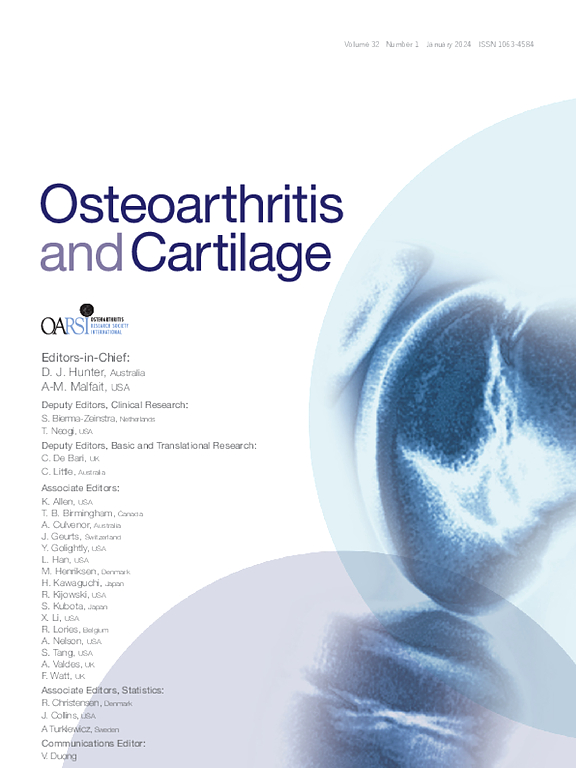Stem Cell Warm-Up via Biomimetic Mechanical Priming Enhances Synovial-Derived MSCs Adaptation for Meniscal Repair.
IF 7.2
2区 医学
Q1 ORTHOPEDICS
引用次数: 0
Abstract
OBJECTIVE Mesenchymal stem cell (MSCs) transplantation shows promise for meniscus repair, but their inadaptability to the in vivo mechanical environment complicates differentiation regulation. This study developed a mechanical priming strategy to enhance MSCs fibrochondrogenic differentiation and promote meniscus repair. METHODS Synovial-derived MSCs (SMSCs) were co-cultured with meniscal fibrochondrocytes and exposed to cyclic tensile strain (10%, 0.5 Hz, 4 h/day) for 5 days as a "stem cell warm-up system". Differentiation and mechanical adaptation were assessed through gene expression, cytoskeletal and nuclear morphology, and YAP-mediated mechanical transduction in vitro. A 2-mm meniscus defect model in New Zealand white rabbits was used, with histological analysis for repair evaluation. RESULTS Mechanical priming inhibited SMSCs hypertrophy and promoted fibrochondrogenesis, with effects lasting 72 hours post-loading. Meanwhile, priming induced actin cap formation, nuclear flattening, and nuclear pore expansion, facilitating mechanical adaptation. YAP-mediated transduction was essential for the sustained upregulation of differentiation-related genes, alongside increased expression of its downstream targets, Ctgf and Cyr61. siRNA silencing of Ctgf and Cyr61 led to a downregulation of differentiation-related genes, with YAP inhibition further suppressed differentiation, underscoring its pivotal role in regulating this process. Primed SMSCs exhibited faster activation and better phenotype maintenance during secondary loading. In vivo, primed SMSCs demonstrated superior performance in meniscus regeneration, equivalent to the outcomes of growth factor-treated groups. CONCLUSIONS This biomimetic priming system enhances MSC differentiation and mechanical adaptability, offering a clinically translatable strategy for meniscus repair and load-bearing tissue regeneration.通过仿生机械启动干细胞热身增强滑膜来源的MSCs对半月板修复的适应性。
目的:间充质干细胞(MSCs)移植修复半月板具有良好的前景,但其对体内机械环境的不适应性使其分化调控复杂化。本研究开发了一种机械启动策略来增强间充质干细胞成纤维软骨分化和促进半月板修复。方法将滑膜来源的间充质干细胞(SMSCs)与半月板纤维软骨细胞共培养,并在循环拉伸应变(10%,0.5 Hz, 4 h/天)下暴露5天作为“干细胞预热系统”。通过基因表达、细胞骨架和细胞核形态以及yap介导的体外机械转导来评估分化和机械适应性。采用新西兰大白兔2-mm半月板缺损模型,通过组织学分析进行修复评价。结果机械启动抑制SMSCs肥大,促进纤维软骨形成,作用持续72小时。同时,启动诱导肌动蛋白帽形成,核变平,核孔扩大,促进机械适应。yap介导的转导对于分化相关基因的持续上调及其下游靶点Ctgf和Cyr61的表达增加至关重要。siRNA沉默Ctgf和Cyr61导致分化相关基因下调,YAP抑制进一步抑制分化,强调其在调控这一过程中的关键作用。诱导后的SMSCs在二次加载过程中表现出更快的活化和更好的表型维持。在体内,诱导的SMSCs在半月板再生方面表现出优异的表现,与生长因子处理组的结果相当。结论该仿生启动系统增强了间充质干细胞的分化和机械适应性,为半月板修复和负重组织再生提供了一种临床可移植的策略。
本文章由计算机程序翻译,如有差异,请以英文原文为准。
求助全文
约1分钟内获得全文
求助全文
来源期刊

Osteoarthritis and Cartilage
医学-风湿病学
CiteScore
11.70
自引率
7.10%
发文量
802
审稿时长
52 days
期刊介绍:
Osteoarthritis and Cartilage is the official journal of the Osteoarthritis Research Society International.
It is an international, multidisciplinary journal that disseminates information for the many kinds of specialists and practitioners concerned with osteoarthritis.
 求助内容:
求助内容: 应助结果提醒方式:
应助结果提醒方式:


